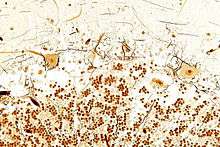Bielschowsky stain

Bielschowsky silver stain showing the processes of basket cells in the cerebellum.
The Bielschowsky technique is a silver staining method used in histochemistry for the visualization of nerve fibers,[1] including multipolar interneurons the cerebellum.[2]
The method is attributed to German neurologist and neurohistologist Max Bielschowsky (1869-1940)[3][4] [5] who made improvements over the previous method developed by Ramon y Cajal (1852-1934).[6]
See also
- Immunohistochemistry
- Neurofilament
- Luxol fast blue stain
References
- ↑ Susan Standring (2008-01-01). Gray's Anatomy: The Anatomical Basis of Clinical Practice, Expert Consult - 40th Edition.
- ↑ Erickson-Davis CR, Faust PL, Vonsattel JP, Gupta S, Honig LS, Louis ED (March 2010). ""Hairy baskets" associated with degenerative Purkinje cell changes in essential tremor". J. Neuropathol. Exp. Neurol. 69 (3): 262–71. doi:10.1097/NEN.0b013e3181d1ad04. PMC 2865233
 . PMID 20142764.
. PMID 20142764. - ↑ Stahnisch, F. W. (2014-10-28). "Max Bielschowsky (1869–1940)". Journal of Neurology. 262 (3): 792–794. doi:10.1007/s00415-014-7544-z. ISSN 0340-5354. PMC 4363476
 . PMID 25346063.
. PMID 25346063. - ↑ Gray's Anatomy- The Anatomical Basis of Clinical Practice, Expert Consult- 40th Edition.
- ↑ "Pioneers in Neurology.". Journal of Neurology.
- ↑ Enersen, Ole Daniel. "Max Bielschowsky". Who Named It. Retrieved 2009-05-31.
This article is issued from Wikipedia - version of the 8/30/2016. The text is available under the Creative Commons Attribution/Share Alike but additional terms may apply for the media files.